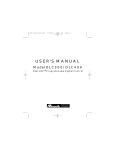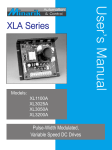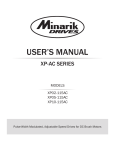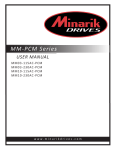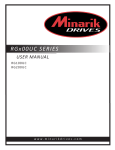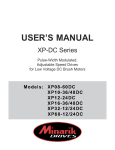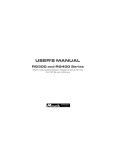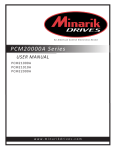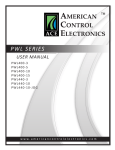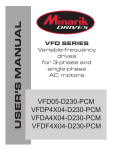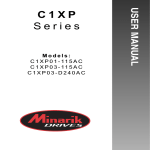Download USER`S MANUAL
Transcript
USER’S MANUAL XP-AC SERIES Pulse-Width Modulated, Adjustable Speed Drives for DC Brush Motors MODEL XP02-115AC-Q Copyright © 2006 by Minarik Corporation All rights reserved. No part of this manual may be reproduced or transmitted in any form without written permission from Minarik Corporation. The information and technical data in this manual are subject to change without notice. Minarik Corporation and its Divisions make no warranty of any kind with respect to this material, including, but not limited, to the implied warranties of its merchantability and fitness for a given purpose. Minarik Corporation and its Divisions assume no responsibility for any errors that may appear in this manual and make no commitment to update or to keep current the information in this manual. Printed in the United States of America. Safety Warnings • Have a qualified electrical maintenance technician install, adjust, and service this equipment. Follow the National Electrical Code and all other applicable electrical and safety codes, including the provisions of the Occupational Safety and Health Act (OSHA) when installing equipment. • Reduce the chance of an electrical fire, shock, or explosion by proper grounding, over current protection, thermal protection, and enclosure. Follow sound maintenance procedures. • It is possible for a drive to run at full speed as a result of a component failure. Install a master switch in the AC line for stopping the drive in an emergency. • This drive is not isolated from Earth ground. Circuit potentials are at 115 VAC above Earth ground. Avoid direct contact with the printed circuit board or with circuit elements to prevent the risk of serious injury or fatality. Use a non-metallic screwdriver for adjusting the calibration trimpots. II Table of Contents Safety Warnings . . . . . . . . . . . . . . . . . . . . . . . . . . . . . . . . . . . . . . . . . . . . . . . . . . . . . . . . . . . . . . . . . . . . . . . . . I Specifications . . . . . . . . . . . . . . . . . . . . . . . . . . . . . . . . . . . . . . . . . . . . . . . . . . . . . . . . . . . . . . . . . . . . . . . . . . . 1 Dimensions . . . . . . . . . . . . . . . . . . . . . . . . . . . . . . . . . . . . . . . . . . . . . . . . . . . . . . . . . . . . . . . . . . . . . . . . . . . . . 2 Installation. . . . . . . . . . . . . . . . . . . . . . . . . . . . . . . . . . . . . . . . . . . . . . . . . . . . . . . . . . . . . . . . . . . . . . . . . . . . . . 3 Mounting . . . . . . . . . . . . . . . . . . . . . . . . . . . . . . . . . . . . . . . . . . . . . . . . . . . . . . . . . . . . . . . . . . . . . . . . . . . . 3 Wiring. . . . . . . . . . . . . . . . . . . . . . . . . . . . . . . . . . . . . . . . . . . . . . . . . . . . . . . . . . . . . . . . . . . . . . . . . . . . . . . 3 Line Fuse. . . . . . . . . . . . . . . . . . . . . . . . . . . . . . . . . . . . . . . . . . . . . . . . . . . . . . . . . . . . . . . . . . . . . . . . . . . . 4 Speed adjust potentiometer . . . . . . . . . . . . . . . . . . . . . . . . . . . . . . . . . . . . . . . . . . . . . . . . . . . . . . . . . . . . . 5 Quick-connect terminal block . . . . . . . . . . . . . . . . . . . . . . . . . . . . . . . . . . . . . . . . . . . . . . . . . . . . . . . . . . . . 6 Connections. . . . . . . . . . . . . . . . . . . . . . . . . . . . . . . . . . . . . . . . . . . . . . . . . . . . . . . . . . . . . . . . . . . . . . . . . . 7 Voltage Follower . . . . . . . . . . . . . . . . . . . . . . . . . . . . . . . . . . . . . . . . . . . . . . . . . . . . . . . . . . . . . . . . . . . . . . 8 Operation. . . . . . . . . . . . . . . . . . . . . . . . . . . . . . . . . . . . . . . . . . . . . . . . . . . . . . . . . . . . . . . . . . . . . . . . . . . . . . . 9 Startup. . . . . . . . . . . . . . . . . . . . . . . . . . . . . . . . . . . . . . . . . . . . . . . . . . . . . . . . . . . . . . . . . . . . . . . . . . . . . . 9 Diagnostic LEDs . . . . . . . . . . . . . . . . . . . . . . . . . . . . . . . . . . . . . . . . . . . . . . . . . . . . . . . . . . . . . . . . . . . . . . 9 Line starting and line stopping. . . . . . . . . . . . . . . . . . . . . . . . . . . . . . . . . . . . . . . . . . . . . . . . . . . . . . . . . . . 10 Inhibit switch. . . . . . . . . . . . . . . . . . . . . . . . . . . . . . . . . . . . . . . . . . . . . . . . . . . . . . . . . . . . . . . . . . . . . . . . . 10 Dynamic braking. . . . . . . . . . . . . . . . . . . . . . . . . . . . . . . . . . . . . . . . . . . . . . . . . . . . . . . . . . . . . . . . . . . . . 10 Calibration . . . . . . . . . . . . . . . . . . . . . . . . . . . . . . . . . . . . . . . . . . . . . . . . . . . . . . . . . . . . . . . . . . . . . . . . . . . . . 12 MIN SPD . . . . . . . . . . . . . . . . . . . . . . . . . . . . . . . . . . . . . . . . . . . . . . . . . . . . . . . . . . . . . . . . . . . . . . . . . . . 12 MAX SPD. . . . . . . . . . . . . . . . . . . . . . . . . . . . . . . . . . . . . . . . . . . . . . . . . . . . . . . . . . . . . . . . . . . . . . . . . . . 12 IR COMP. . . . . . . . . . . . . . . . . . . . . . . . . . . . . . . . . . . . . . . . . . . . . . . . . . . . . . . . . . . . . . . . . . . . . . . . . . . 12 TORQUE. . . . . . . . . . . . . . . . . . . . . . . . . . . . . . . . . . . . . . . . . . . . . . . . . . . . . . . . . . . . . . . . . . . . . . . . . . . 13 Application Notes. . . . . . . . . . . . . . . . . . . . . . . . . . . . . . . . . . . . . . . . . . . . . . . . . . . . . . . . . . . . . . . . . . . . . . . 14 Multiple fixed speeds. . . . . . . . . . . . . . . . . . . . . . . . . . . . . . . . . . . . . . . . . . . . . . . . . . . . . . . . . . . . . . . . . . 14 Adjustable speeds using potentiometers in series. . . . . . . . . . . . . . . . . . . . . . . . . . . . . . . . . . . . . . . . . . . 14 Independent adjustable speeds . . . . . . . . . . . . . . . . . . . . . . . . . . . . . . . . . . . . . . . . . . . . . . . . . . . . . . . . . 15 RUN/JOG switch. . . . . . . . . . . . . . . . . . . . . . . . . . . . . . . . . . . . . . . . . . . . . . . . . . . . . . . . . . . . . . . . . . . . . 16 Connection to other Minarik devices. . . . . . . . . . . . . . . . . . . . . . . . . . . . . . . . . . . . . . . . . . . . . . . . . . . . . . 17 Leader-follower application. . . . . . . . . . . . . . . . . . . . . . . . . . . . . . . . . . . . . . . . . . . . . . . . . . . . . . . . . . . . . 18 Single speed potentiometer control of multiple drives. . . . . . . . . . . . . . . . . . . . . . . . . . . . . . . . . . . . . . . . 19 Reversing. . . . . . . . . . . . . . . . . . . . . . . . . . . . . . . . . . . . . . . . . . . . . . . . . . . . . . . . . . . . . . . . . . . . . . . . . . . 20 Troubleshooting . . . . . . . . . . . . . . . . . . . . . . . . . . . . . . . . . . . . . . . . . . . . . . . . . . . . . . . . . . . . . . . . . . . . . . . . 21 Before troubleshooting . . . . . . . . . . . . . . . . . . . . . . . . . . . . . . . . . . . . . . . . . . . . . . . . . . . . . . . . . . . . . . . . 21 Replacement Parts. . . . . . . . . . . . . . . . . . . . . . . . . . . . . . . . . . . . . . . . . . . . . . . . . . . . . . . . . . . . . . . . . . . . . . 24 Unconditional Warranty. . . . . . . . . . . . . . . . . . . . . . . . . . . . . . . . . . . . . . . . . . . . . . . . . . . . inside back cover III Illustrations Figure 1. Figure 2. Figure 3. Figure 4. Figure 5. Figure 6. Figure 7. Figure 8. Figure 9. Figure 10. Figure 11. Figure 12. Figure 13. Figure 14. Figure 15. Figure 16. Figure 17. Figure 18. XP02-115AC-Q Dimensions. . . . . . . . . . . . . . . . . . . . . . . . . . . . . . . . . . . . . . . . . . . . . . . . . . . 2 Fuseholder. . . . . . . . . . . . . . . . . . . . . . . . . . . . . . . . . . . . . . . . . . . . . . . . . . . . . . . . . . . . . . . . . 4 Speed Adjust Potentiometer. . . . . . . . . . . . . . . . . . . . . . . . . . . . . . . . . . . . . . . . . . . . . . . . . . . 5 Quick-Connect Terminal Block . . . . . . . . . . . . . . . . . . . . . . . . . . . . . . . . . . . . . . . . . . . . . . . . . 6 XP02-115AC-Q Connections. . . . . . . . . . . . . . . . . . . . . . . . . . . . . . . . . . . . . . . . . . . . . . . . . . . 7 Voltage Signal Connections. . . . . . . . . . . . . . . . . . . . . . . . . . . . . . . . . . . . . . . . . . . . . . . . . . . . 8 Diagnostic LEDs. . . . . . . . . . . . . . . . . . . . . . . . . . . . . . . . . . . . . . . . . . . . . . . . . . . . . . . . . . . . . 9 Inhibit Switch . . . . . . . . . . . . . . . . . . . . . . . . . . . . . . . . . . . . . . . . . . . . . . . . . . . . . . . . . . . . . . 10 Dynamic Brake Connection. . . . . . . . . . . . . . . . . . . . . . . . . . . . . . . . . . . . . . . . . . . . . . . . . . . 11 Typical TORQUE and IR COMP Settings. . . . . . . . . . . . . . . . . . . . . . . . . . . . . . . . . . . . . . . . 13 Multiple Fixed Speeds. . . . . . . . . . . . . . . . . . . . . . . . . . . . . . . . . . . . . . . . . . . . . . . . . . . . . . . 14 Adjustable Fixed Speeds Using Potentiometers in Series . . . . . . . . . . . . . . . . . . . . . . . . . . 14 Independent Adjustable Speeds . . . . . . . . . . . . . . . . . . . . . . . . . . . . . . . . . . . . . . . . . . . . . . 15 RUN/JOG Switch Connection . . . . . . . . . . . . . . . . . . . . . . . . . . . . . . . . . . . . . . . . . . . . . . . . 16 XP02-115AC-Q Connections to Minarik Devices . . . . . . . . . . . . . . . . . . . . . . . . . . . . . . . . . 17 Leader-Follower Application. . . . . . . . . . . . . . . . . . . . . . . . . . . . . . . . . . . . . . . . . . . . . . . . . . 18 Single Speed Potentiometer Control of Multiple Drives . . . . . . . . . . . . . . . . . . . . . . . . . . . . 19 Reversing Circuit Connection. . . . . . . . . . . . . . . . . . . . . . . . . . . . . . . . . . . . . . . . . . . . . . . . . 20 Specifications Model AC Line Voltage Horsepower Range (with 130 VDC motors) Armature Voltage Maximum Continuous Armature Current Form Factor (at base speed) Acceleration Time (with load) Deceleration Time (with load) Analog Input Voltage Range (isolated; S1 to S2) Input Impedance (S1 to S2) Speed Regulation Ambient Temperature Range Weight XP02-115AC-Q 115 VAC, ±10%, 50/60 Hz, single phase 1/20 – 1/3 HP 0 – 130 VDC 2 ADC 1.05 1 second 2 seconds 0 – 5 VDC > 100K ohms 1% of base speed or better 10° C – 40° C 0.6 lbs Dimensions 0.19 [5] 3.58 [91] 1.75 [44] MAX SPD P501 TORQUE P502 MIN SPD P503 0.74 [19] IR COMP P504 0.65 [16] 3.80 [97] 4.30 [109] 0.19 [5] 2.15 [55] 1.28 [33] 0.97 [25] Figure 1. XP02-115AC-Q Dimensions Installation Mounting • Drive components are sensitive to electrostatic fields. Avoid contact with the circuit board directly. Hold the drive by the chassis only. • Protect the drive from dirt, moisture, and accidental contact. Provide sufficient room for access to the terminal block and calibration trimpots. • Mount the drive away from other heat sources. Operate the drive within the specified ambient operation temperature range. • Prevent loose connections by avoiding excessive vibration of the drive. • Mount drive with its board in either a horizontal or vertical plane. Six 0.19 in. (5 mm) wide slots in the chassis accept #8 pan head screws. Fasten either the large base or the narrow flange of the chassis to the subplate. • The chassis must be Earth grounded. Use a star washer beneath the head of at least one of the mounting screws to penetrate the anodized chassis surface and to reach bare metal. Wiring • Use 18 AWG wire for speed adjust potentiometer wiring. Use 16 AWG wire for motor and AC line voltage wiring. • Twist logic wires (for speed adjust potentiometer and inhibit) to avoid picking up unwanted electrical noise. Use shielded cable if wires are longer than 18 in. (46 cm). • Keep logic wires away from power carrying lines or sources of electrical noise that can cause erratic operation. Never run speed adjust potentiometer or inhibit wires in the same conduit used for the motor and AC line voltage wires. • It may be necessary to Earth ground the shielded cable. If noise is produced by devices other than the drive, ground the shield at the drive end. If noise is generated by a device on the drive, ground the shield at the end away from the drive. Do not ground both ends of the drive. Line Fuse All XP02-115AC-Q drives are protected by a 5A, 250V AC line fuse. The fuse does not have to be resized as long as the motor used is within the drive’s specified horsepower range. The fuse is mounted in the fuseholder (see Figure 2). To replace a blown fuse, use a screwdriver to turn the fuseholder knob counterclockwise. Remove the blown fuse and replace with a new fuse. Fuseholder Knob Figure 2. Fuseholder Speed adjust potentiometer Mount the speed adjust potentiometer through a 0.38 in. (10 mm) hole with the hardware provide (Figure 3.) Install the circular insulating disk between the panel and the 10K ohm speed adjust potentiometer. Twist the speed adjust potentiometer wire to avoid picking up unwanted electrical noise. If potentiometer leads are longer than 18 in. (457 mm), use shielded cable (see Wiring section). m Warning Be sure that the potentiometer tabs do not make contact with the potentiometer enclosure. Grounding the input will cause damage to the drive. MOUNT THROUGH A 0.38 IN. (10 MM) HOLE CW WIPER CCW NUT STAR WASHER SPEED ADJUST POTENTIOMETER INSULATING DISK PANEL Figure 3. Speed Adjust Potentiometer POT TAB ASSIGNMENTS Quick-connect terminal block The quick-connect terminal block has an 8-pin header block and 8-screw terminal plug (Figure 4). To use the quick-connect terminal block: 1. Carefully pull terminal plug from header block. 2. With a small flat-head screwdriver, turn terminal plug screw counterclockwise to open wire clamp. 3. Insert stripped wire into the large opening in front of the plug. 4. Turn the terminal plug screw clockwise to clamp the wire. 5. Repeat steps 2 – 4 for each terminal until all connections are made. 6. Insert plug into header until securely fastened. Terminal Plug Header Block Figure 4. Quick-Connect Terminal Block Connections MAX SPD P501 TORQUE P502 MIN SPD P503 L1 L2 A1 A2 S3 S2 H2 S1 IR COMP P504 H1 CW 10K SPD ADJ POT Line Voltage 115 Vac Motor Armature Figure 5. RUN STOP Inhibit Switch (optional) XP02-115AC-Q Connections ASSUMPTIONS: Minarik drives supply motor voltage from A1 and A2 terminals. It is assumed through this manual that, when A1 is positive with respect to A2, the motor will rotate clockwise (CW) while looking at the output shaft protruding from the front of the motor. If this is opposite of the desired rotation, simply reverse the wiring of A1 and A2 with each other. Voltage Follower Instead of using a speed adjust potentiometer, the drive may be wired to follow a 0 – 5 VDC voltage signal that is isolated from Earth ground (Figure 6). Connect the signal input ( + ) to S2. Connect the signal common ( - ) to S1. Make no connection to S3. A potentiometer can be used to scale the analog input voltage. To achieve greater linearity and control, use an interface device such as Minarik ® model PCM4 to scale the analog input voltage. L1 L2 A1 A2 S3 S2 H2 S1 H1 0 - 5 VDC Isolated Voltage Signal Input Figure 6. Voltage Signal Connections Operation Startup Note: Before applying power, verify that no foreign conductive material is placed on the printed circuit board. To start the drive: 1. Turn the speed adjust potentiometer full counterclockwise (CCW). If the drive is following a voltage signal, set the voltage signal to 0 VDC. 2. Apply AC line voltage. 3. Slowly advance the speed adjust potentiometer clockwise (CW). If the drive is following a voltage signal, slowly increase the voltage signal. The motor slowly accelerates as the potentiometer is turned CW, or the voltage signal is increased. Continue until the desired speed is reached. 4. Remove AC line voltage form the drive to coast the motor to a stop. If the motor or drive does not perform as described, disconnect the AC line voltage immediately. Refer to the Troubleshooting section for further assistance. Diagnostic LEDs All XP02-115AC-Q drives are equipped with diagnostic LEDs. See Figure 7 for LED locations. POWER (PWR): Green LED lights whenever AC line voltage is applied to drive. CURRENT LIMIT (CUR LIM): Red LED lights whenever the drive reaches current limit. L1 L2 A1 A2 S3 S2 H2 S1 H1 POWER LED (green) Figure 7. Diagnostic LEDs CURRENT LIMIT LED (red) 10 Line starting and line stopping Line starting and line stopping (applying and removing AC line voltage) is recommended for infrequent starting and stopping of a drive only.. When AC line voltage is applied to the drive, the motor accelerates to the speed set by the speed adjust potentiometer. When AC line voltage is removed, the motor coasts to a stop. Inhibit switch An inhibit switch allows the motor to decelerate to zero speed when the switch is closed. Connect a single pole, single throw switch between H1 and H2 (see Figure 8). Close the switch to decelerate to the motor to zero speed. Open the switch to accelerate the motor to set speed. An open-collector output rated for at least 10 mA (ICE) may also be used as an inhibit switch. Wire the collector to H1, and the emitter to H2. L1 L2 A1 A2 S3 S2 H2 S1 H1 RUN STOP Inhibit Switch (optional) Figure 8. Inhibit Switch Dynamic braking Dynamic braking may be used to rapidly stop a motor (Figure 9). For the RUN/BRAKE switch, use a double pole, double throw switch rated for at least the maximum DC armature voltage and maximum braking current. 11 A2 MOTOR 1Ω / 1W Dynamic Brake Resistor RUN A1 BRAKE H2 H1 Figure 9. Dynamic Brake Connection A 1 Ω, 1W resistor is used as the dynamic brake resistor. For motors rated 1/17 horsepower and lower, a dynamic brake resistor is not necessary since the armature resistance is high enough to stop the motor without demagnetization. In this case, replace the dynamic brake resistor with 12 gauge wire. m Warning Wait for the motor to completely stop before switching it back to RUN. This will prevent high armature currents from damaging the motor or drive. 12 Calibration Each drive is factory calibrated to its maximum horsepower rating. Readjust the calibration trimpot settings to accommodate lower horsepower motors. All adjustments increase with CW rotation, and decrease with CCW rotation. Use a non-metallic screwdriver for calibration. Each trimpot is identified on the printed circuit board. MIN SPD The MIN SPD setting determines the motor speed when the speed adjust potentiometer is turned full CCW. It is factory set for zero speed. To calibrate turn the speed adjust potentiometer full CCW. Adjust the MIN SPD trimpot until the motor has stopped, or is running at the desired minimum speed. MAX SPD The MAX SPD setting determines the motor speed when the speed adjust potentiometer is turned full CW. It is factory set for maximum rated speed. To calibrate, set the MAX SPD trimpot full CCW. Turn the speed adjust potentiometer full CW. Adjust the MAX SPD trimpot until the desired maximum motor speed is reached. Note: Check the MIN SPD and MAX SPD adjustments after recalibrating to verify that the motor runs at the desired minimum and maximum speed. IR COMP The IR COMP setting determines the degree to which motor speed is held constant as the motor load changes. It is factory calibrated for a 1/8 HP, 90 VDC motor. Recalibrate the IR COMP setting when using a lower horsepower motor. Refer to the recommended IR COMP settings in Figure 10, or recalibrate using the following procedure: If the motor does not maintain set speed as the load changes, gradually rotate the IR COMP trimpot CW. If the motor oscillates (overcompensation), the IR COMP trimpot may be set too high (CW). Turn the IR COMP trimpot CCW to stabilize the drive. 13 TORQUE The TORQUE setting determines the maximum armature current output of the drive. It is factory calibrated for a 1/8 HP, 90 VDC motor. Recalibrate the TORQUE setting when using a lower horsepower motor. Refer to the recommended TORQUE settings in Figure 10, or recalibrate using the following procedure: 1. With the power disconnected from the control, connect a DC ammeter (0 – 15 A minimum scale) in series with the armature. 2. Set the TORQUE trimpot to minimum (full CCW). 3. Connect power to the drive. The motor should remain stopped. 4. Lock the motor armature. Be sure that the motor is firmly mounted. 5. Set the speed adjust potentiometer to maximum (full CW). 6. Adjust the TORQUE trimpot CW slowly until the armature current is 120% of motor rated armature current. 7. Set the speed adjust potentiometer to minimum and remove the stall from the motor. TORQUE * TORQUE IR COMP IR COMP 1/4 HP 130 VDC 2500 RPM 1.40 ADC 1/8 HP 90 VDC 1800 RPM 1.30 ADC TORQUE TORQUE IR COMP IR COMP 1/8 HP 130 VDC 2500 RPM 1.00 ADC TORQUE IR COMP 1/10 HP 90 VDC 1725 RPM 1.10 ADC 1/15 HP 90 VDC 1800 RPM 0.75 ADC 1/20 HP 90 VDC 1750 RPM 0.56 ADC TORQUE IR COMP * factory settings Figure 10. Typical TORQUE and IR COMP Settings (Actual settings may vary with each application) 14 Application Notes Multiple fixed speeds Replace the speed adjust potentiometer with series resistors with a total series resistance of 10K ohms (Figure 11). Add a single pole, multi-position switch with the correct number of positions for the desired number of fixed speeds. S3 Total Series Resistance 10K Ohms S2 S1 Figure 11. Multiple Fixed Speeds Adjustable speeds using potentiometers in series Replace the speed adjust potentiometer with a single pole, multi-position switch, and two or more potentiometers in series, with a total series resistance of 10K ohms. Figure 12 shows a connection for fixed high and low speed adjust potentiometers. CW S3 High Speed 5K Ohm S2 S1 Low Speed CW 5K Ohm Figure 12. Adjustable Fixed Speeds Using Potentiometers in Series 15 Independent adjustable speeds Replace the speed adjust potentiometer with a single pole, multi-position switch, and two or more potentiometers in parallel, with a total parallel resistance of 10K ohms. Figure 13 shows the connection of two independant speed adjust potentiometers that can be mounted at two separate operating stations. S3 SPEED 2 CW CW S2 SPEED 1 20K ohm S1 Figure 13. Independent Adjustable Speeds 20K ohm 16 RUN/JOG switch Using a RUN/JOG switch is recommended in applications where quick stopping is not needed and frequent jogging is required. Use a single pole, single throw switch for the RUN/JOG switch, and a single pole, normally closed, momentary operated pushbutton for the JOG pushbutton (see Figure 14). When the RUN/JOG switch is set to JOG, the motor decelerates to zero speed. Press the JOG pushbutton to jog the motor. Return the RUN/JOG switch to RUN for normal operation. MAX SPD P501 TORQUE P502 MIN SPD P503 L1 L2 A1 A2 S3 S2 H2 S1 CW 10K Ohm H1 RUN JOG Figure 14. IR COMP P504 RUN/JOG Switch Connection JOG Pushbutton 17 Connection to other Minarik devices S3 PCM4 2 S2 1 S1 XP02-115AC-Q S3 DLC600 Figure 15. S2 S2 S1 S1 XP02-115AC-Q XP02-115AC-Q Connections to Minarik Devices (PCM4, DLC100, and DLC300) 18 Leader-follower application In this application, use a PCM4 to monitor the speed of the leader motor (Figure 16). The PCM4 isolates the leader motor from the follower drive, and outputs a voltage proportional to the leader motor armature voltage. The follower drive uses this voltage reference to set the speed of the follower motor. An optional ratio potentiometer may be used to scale the PCM4 output voltage. A1 Leader Drive 9 MOTOR A2 (+) PCM4 8 7 (-) TB501 Figure 16. (+) 2 (-) 1 S2 Follower Drive TB502 S1 10K Ohm (optional) Leader-Follower Application 19 Single speed potentiometer control of multiple drives Multiple drives can be controlled with a single speed adjust potentiometer using a PCM4 at the input of each drive to provide isolation (Figure 17). Optional ratio potentiometers can be used to scale the PCM4 output voltage, allowing independent control of each drive. 6 8 2 ratio pot A (optional) 10KΩ PCM4 S1 A1 DRIVE A 7 TB501 MOTOR A2 TB502 6 8 S2 1 2 PCM4 ratio pot B (optional) 10KΩ S1 A1 DRIVE B 7 TB501 Figure 17. 1 S2 TB502 Single Speed Potentiometer Control of Multiple Drives MOTOR A2 20 Reversing A dynamic brake may be used when reversing the motor direction (Figure 18). Use a three pole, three position switch rated for at least the maximum DC armature voltage and maximum braking current. Wait for the motor to stop completely before switching it to either the forward or reverse direction. A2 Forward Brake Reverse MOTOR A1 H2 H1 Figure 18. Reversing Circuit Connection 1Ω / 1W Dynamic Brake Resistor 21 Troubleshooting m Warning Dangerous voltages exist on the drive when it is powered. When possible, disconnect the AC line voltage from the drive while troubleshooting. Be Alert. High voltages can cause serious or fatal injury. Before troubleshooting Perform the following steps before starting any procedure in this section: • Disconnect AC line voltage from the drive. • Check the drive closely for damaged components. • Check that no conductive or other foreign material has become lodged on the printed circuit board. • Verify that every connection is correct and in good condition. • Verify that there are no short circuits or grounded connections. • Check that the voltage selection switch settings match the AC line and output voltages. • Check that the drive’s rated armature and field outputs are consistent with the motor ratings. 22 Motor does not run 1. Check for blown fuses or tripped circuit breaker. 2. Verify that the speed adjust potentiometer is not set to zero speed position. 3. Verify that the inhibit terminals (H1 and H2) are not shorted together. 4. Verify that the drive is receiving AC line voltage. 5. Check that the drive is not in current limit. The red current limit (CUR LIM) LED must be off. If the red current limit LED is on, verify that the motor is not jammed. It may be necessary to increase the TORQUE setting if it is set to a value lower than the current rating of the motor. Fuses or circuit breaker blows 1. Check all wiring for shorts, grounds, or misconnections. 2. Check that the drive is configured to match the motor rating. 3. Check that the motor is not jammed or restricted from movement. 4. Check that the fuse size is correct for the motor being driven. Motor runs too fast at the maximum speed setting 1. Check that the MIN SPD and MAX SPD settings are not set too high. 2. Check that the field output connections are secure if you are using a shunt wound motor. Motor will not stop when the speed adjust potentiometer is full CCW 1. Turn the MIN SPD trimpot CCW until the motor stops. Motor runs in the opposite direction 1. Remove AC line voltage. 2. Reverse connections to the motor armature. 23 Motor slows under load 1. Check that the drive has been correctly calibrated for the motor. 2. Check that the motor is not overloaded. 3. Readjust the IR COMP slightly CW until motor runs at proper speed. Motor is unstable under load 1. Readjust the IR COMP setting slightly CCW until motor speed is stabilized. Motor only runs at full speed 1. Check that S2 and S3 are not shorted together. For additional assistance, contact your local Minarik® distributor, or the factory direct: Phone: (800) 646-2745 Fax: (815) 624-6960 24 Replacement Parts Replacement parts are available from Minarik Corporation and its distributors for this drive series. BR501 C503 D501 FU501 Q501 R501 R502 GBU8J Bridge 470 μF, 400 VDC Capacitor 16 A, 300V Diode Fuse Holder Power MOSFET 0.2 Ω, 5 W Resistor 6.8 KΩ, 10 W Resistor 5 A, 3 AG Fast-Acting Fuse 10 KΩ Potentiometer Kit (with Terminal Plug) 073-0006 011-0120 071-0054 050-0050 070-0043 032-0093 032-0103 050-0022 202-0074 25 Unconditional Warranty A. Warranty Minarik Drives warrants that its products will be free from defects in workmanship and material for twelve (12) months or 3,000 hours, whichever comes first, from date of manufacture thereof. Within this warranty period, Minarik Drives will repair or replace, at its sole discretion, such products that are returned to Minarik Drives, 14300 De La Tour Drive, South Beloit, IL 61080 USA. This warranty applies only to standard catalog products, and does not apply to specials. Any returns for special controls will be evaluated on a case-by-case basis. Minarik Drives is not responsible for removal, installation, or any other incidental expenses incurred in shipping the product to and from the repair point. B. Disclaimer The provisions of Paragraph A are Minarik Drives sole obligation and exclude all other warranties of merchantability for use, express or implied. Minarik Drives further disclaims any responsibility whatsoever to the customer or to any other person for injury to the person or damage or loss of property of value caused by any product that has been subject to misuse, negligence, or accident, or misapplied or modified by unauthorized persons or improperly installed. C. Limitations of Liability In the event of any claim for breach of any of Minarik Drives obligations, whether express or implied, and particularly of any other claim or breech of warranty contained in Paragraph A, or of any other warranties, express or implied, or claim of liability that might, despite Paragraph B, be decided against Minarik Drives by lawful authority, Minarik Drives shall under no circumstances be liable for any consequential damages, losses, or expense arising in connection with the use of, or inability to use, Minarik Drives product for any purpose whatsoever. An adjustment made under warranty does not void the warranty, nor does it imply an extension of the original 12-month warranty period. Products serviced and/or parts replaced on a no-charge basis during the warranty period carry the unexpired portion of the original warranty only. If for any reason any of the foregoing provisions shall be ineffective, Minarik Drives liability for damages arising out of its manufacture or sale of equipment, or use thereof, whether such liability is based on warranty, contract, negligence, strict liability in tort, or otherwise, shall not in any event exceed the full purchase price of such equipment. Any action against Minarik Drives based upon any liability or obligation arising hereunder or under any law applicable to the sale of equipment or the use thereof, must be commenced within one year after the cause of such action arises. MINARIK DRIVES www.minarikdrives.com 14300 De La Tour Drive, South Beloit, IL 61080 Phone: (800) MINARIK (646-2745); Fax: (800) 394-6334 Document Number: 250-0213, Revision 1; Printed in the U.S.A. - April 2006
































